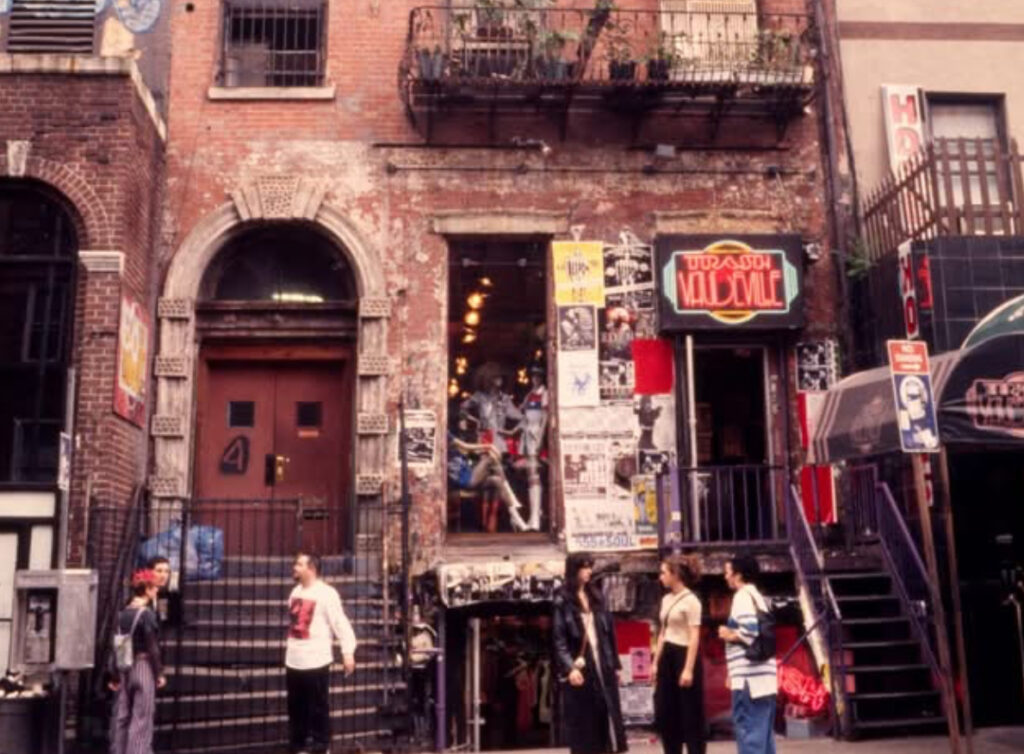In the epicenter of New York City’s East Village, St. Marks Place has long been a symbol of counterculture, rebellion, and artistic expression. In 1995, Trash and Vaudeville, a legendary punk rock boutique, stood at the pithy of this movement, serving as the go-to spot for punks, rockers, and misfits searching for the perfect leather jacket, ripped jeans, or sky-high platform boots.
Photographer Susan De Vries captured this iconic era in a now-historic image, documenting a time when St. Marks Place pulsed with raw energy and individuality. But Trash and Vaudeville was more than just a clothing store—it was a cultural institution, shaping the fashion and attitude of a generation.
In this article, we explore the history of Trash and Vaudeville, its impression on New York’s punk scene, and why 1995 marked a pivotal moment for both the shop and St. Marks Place itself.
The Birth of Trash and Vaudeville: A Punk Fashion Revolution
Founded in 1975 by Ray Goodman, Trash and Vaudeville opened its doors on 4 St. Marks Place, a historic building that once housed Andy Warhol’s Exploding Plastic Inevitable in the 1960s. Goodman, a rock-and-roll aficionado, envisioned a boutique that would cater to the city’s growing punk and glam rock subcultures, offering bold, rebellious fashion that rejected mainstream trends.
By the 1980s and 1990s, Trash and Vaudeville had cemented its status as a punk mecca. The store was a beacon for fans of bands like the Ramones, Blondie, the New York Dolls, and the Dead Boys—many of whom were regular customers.
Goodman’s philosophy was simple: rock ‘n’ roll isn’t just music—it’s a way of life, and fashion is a key part of that identity. His store provided the battle armor for the city’s rebels, misfits, and dreamers.
1995: A Defining Year for Trash and Vaudeville
By the mid-1990s, New York’s punk scene was evolving. The gritty, rebellious energy of the CBGB-era punk movement was giving way to a more commercialized, alternative rock culture. Yet, in 1995, Trash and Vaudeville remained a stronghold of authenticity.
At the time, the East Village still retained much of its raw, underground energy. While gentrification had begun creeping into Manhattan, St. Marks Place was still lined with tattoo parlors, record shops, dive bars, and street vendors selling bootleg cassettes and vinyl records. It was a place where punks, goths, metalheads, and skaters all coexisted, united by their love of rebellion and self-expression.
Trash and Vaudeville in 1995 was where you went to buy your first pair of Dr. Martens, ripped fishnet stockings, or a studded leather belt. The store wasn’t just a retailer—it was a gathering place for the city’s subcultures, where you could rub shoulders with local musicians, artists, and even the occasional rock star passing through town.
Inside Trash and Vaudeville: A Paradise for Punks and Misfits
Walking into Trash and Vaudeville in 1995 was an assault on the senses in the best way possible.
• Loud punk and glam rock blasted through the speakers, setting the tone for a chaotic yet exhilarating shopping experience.
• Walls were lined with band posters, graffiti, and neon signs, creating an atmosphere that felt more like a rock club than a clothing store.
• Leather jackets, tight jeans, and platform boots filled the racks, offering styles that ranged from Sex Pistols-inspired punk to David Bowie-esque glam.
• Sales associates were often punk and goth veterans themselves, dressed in outfits that looked straight out of a 1970s CBGB show.
The store was famous for its no-nonsense attitude. It wasn’t a place for passive browsing—you either embraced the punk spirit, or you felt out of place.
One of the most legendary figures in Trash and Vaudeville’s history was Jimmy Webb, a longtime employee who became synonymous with the store. Webb, with his flamboyant style, jet-black hair, and infectious energy, was a punk fashion guru, dressing everyone from Iggy Pop and Debbie Harry to Billie Joe Armstrong and Slash. His love for the store and its customers made him a key part of its legacy.
St. Marks Place in 1995: The Last Gasp of Old New York
While 1995 was a vibrant year for Trash and Vaudeville, it was also a turning point for St. Marks Place and the East Village.
The early 1990s still maintained much of the neighborhood’s underground energy, but changes were on the horizon. Rising rents and increasing commercialization were starting to push out some of the small businesses and DIY punk spots that had defined the area.
However, in 1995, St. Marks Place was still a haven for punk, goth, and alternative culture. On any given day, you could see:
• Street vendors selling handmade jewelry, vintage records, and punk patches
• Bands handing out flyers for underground gigs
• Skaters weaving through the crowded sidewalks
• Tattooed punks lounging outside dive bars, cigarette in hand
It was gritty, rebellious, and unapologetically itself—qualities that Trash and Vaudeville embodied perfectly.
The Decline of St. Marks Place and Trash and Vaudeville’s Move
By the early 2000s, the forces of gentrification were accelerating. Trendy chain stores, upscale condos, and corporate interests began reshaping the neighborhood. Slowly, many of the East Village’s iconic punk institutions closed their doors—CBGB shut down in 2006, and other beloved haunts like Sounds Records and Kim’s Video followed suit.
In 2016, after over 40 years at 4 St. Marks Place, Trash and Vaudeville was forced to move due to rising rent costs. The store relocated to 7th Street, a few blocks away, marking the end of an era. While the new location maintained the brand’s punk spirit, something about leaving St. Marks Place felt like the closing of a chapter.
Trash and Vaudeville’s Legacy Today
Despite leaving its original home, Trash and Vaudeville remains an institution in punk fashion and culture. Its impact on New York’s alternative scene is undeniable, influencing countless musicians, designers, and fans of rock ‘n’ roll rebellion.
Today, St. Marks Place has changed dramatically. Many of its punk and alternative landmarks have been replaced by upscale eateries, sneaker boutiques, and luxury apartments. The street that once symbolized counterculture is now a mix of its old, rebellious spirit and the forces of modern consumerism.
Yet, for those who walked its sidewalks in the 1990s, St. Marks Place—and Trash and Vaudeville—will always be remembered as a sanctuary for outsiders, a birthplace of punk fashion, and a home for those who refused to conform.
Thoughts
Trash and Vaudeville in 1995 was more than just a store—it was a cultural landmark, a place where fashion, music, and rebellion intersected. Susan De Vries’ photograph captures this era in all its chaotic, untamed glory—a time when St. Marks Place was still a hub for misfits and dreamers, and punk wasn’t just a genre but a way of life.
Though the East Village has changed, the spirit of Trash and Vaudeville endures. Whether through its current store, its influence on fashion, or the memories of those who lived through its golden age, its punk legacy will never die.
No comments yet.







